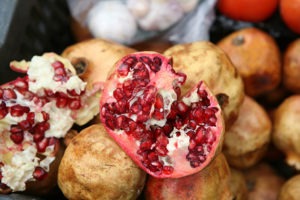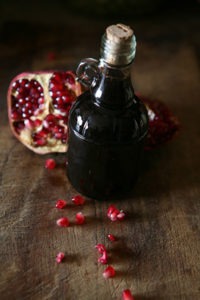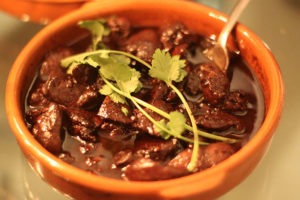Author, photographer, food consultant and TV host, Barbara Abdeni Assaad tells us a thing or two about pomegranate molasses.

Photo – Pavillion Books
When lemon trees were scarce in Lebanon and the tangy taste, which we so much cherish was demanded, our forefathers came up with other ways to find sour and zesty flavors with different types of fruit.
Local unripe grapes were crushed and the juice was boiled to a concentrate to make verjuice, hoosroom in Arabic. Another important condiment was made with sour pomegranate. Juice was extracted from the seeds of the fruit, strained and boiled into thick syrup producing pomegranate molasses, debs remman in Arabic.

This thick dark brown liquid is very much appreciated today in many households and is also used in traditional restaurants throughout the country.
“A Spoonful of Pomegranate Molasses is Perfect to Flavor Meat Stuffing for Meat Crescents.”
The taste of pomegranate molasses is intensely sour with a hint of sweetness and is an indispensable item in our mouneh, our local traditional preserves.
To make debs remman is no small task. And do be careful working with pomegranates, as the juice will stain your hands and clothes.
Invite the neighbors and get a huge pot going, as you need a minimum quantity to get good results.
A spoonful of pomegranate molasses is perfect to flavor meat stuffing for meat crescents.
Cooks use a mixture of lemon juice and pomegranate molasses to deglaze favorites such as makanek, Lebanese sausages, chicken liver or birds cooked in season. The outcome is a sweet and sour bliss!
The best pomegranate molasses is thick and sticky. To gauge this, tilt the bottle.
Good molasses should move slowly and coat the sides of the bottle. Good-quality pomegranate molasses will also be a deep, rich red — so red that it appears almost brown or even nearly black. This is because pomegranate juice naturally darkens in color as the processor cooks off its moisture.
POMEGRANATE MOLASSES
Ingredients: Makes 1 bottle
- 10 kg sour pomegranate
- 40 g ground coarse sea salt
- Olive oil
Preparation:
- Wash the pomegranates and dry with a kitchen towel.
- Trim the crown of the pomegranate using a sharp paring knife and then slice it.
- If the fruit is juicy, squeeze the fresh juice out using a lemon squeezer.
- Alternatively, cut the outside skin around the pomegranate without touching the arils and separate the fruit into 5 to 6 wedges.
- Open the fruit with your thumb and scoop the arils into a clean dish, removing the white membrane.
- Blend the arils in a food processor or blender.
- Strain the liquid through a sieve lined with a sterilized cloth.
- Pour the liquid into a nonreactive pan.
- Bring the mixture to a boil, stirring occasionally.
- Boil until the liquid thickens into a paste.
- The time of cooking may take about 2 hours, depending on the amount of juice extracted from the fruit.
- Thoroughly skim the froth from the surface. Add the salt towards the end of the cooking.
- Mix thoroughly until it completely dissolves.
- Pour the syrup in a sterilized bottle.
- Top with olive oil to seal.
- Close the lid of the bottle tightly making sure the cover is well secured.
- Label the bottle and store in a cool dark place, if not for immediate consumption.
- Keep for a year.
CHICKEN LIVER WITH POMEGRANATE MOLASSES
Ingredients Serves 3 – 4
- ½ kg chicken liver
- 1 clove garlic
- 2 tbsp. pomegranate molasses
- 2 tbsp. vegetable oil
- Juice of 1-2 lemons
- Fine sea salt
- Freshly ground black pepper
- Few sprigs finely chopped
- coriander or parsley
Preparation:
- It is important to clean the liver carefully, removing loose nerves or blood clots.
- Crush garlic with a little salt with a mortar and pestle.
- Add the pomegranate molasses and lemon juice to the garlic mixture and set aside.
- Fry the chicken liver in a skillet with oil until golden brown. Don’t overcook, as the pieces will become rubbery.
- Add the crushed garlic mixture and blend.
- Season with salt and pepper to taste.
- Garnish with chopped coriander or parsley.
- Serve warm.
Article published on February 16, 2021.
Article edited on October 6, 2021.
Loading


